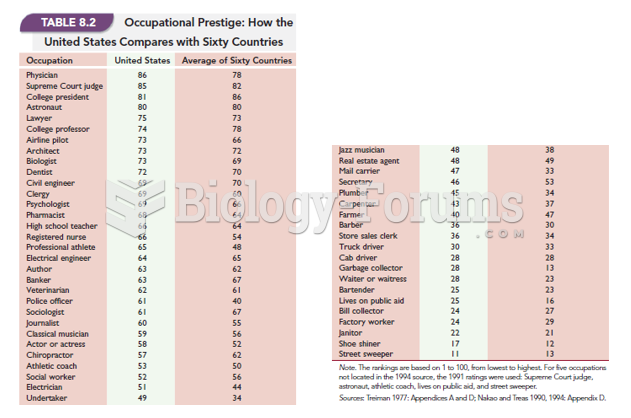Answer to Question 1
2
Rationale:
1. Teens might not understand the physiology behind the profound body changes of pregnancy. Pregnant adolescents are just adapting to a new body image created by the changes of puberty, when the pregnancy produces rapid and substantial body changes. The desire to maintain a socially desirable figure can lead to nutritional deficits. The first role of the nurse is to explain why food is important to the growing fetus, specifying how each food group will help the fetus develop. Next, the nurse must assist the pregnant adolescent to plan foods that she likes to eat from each food group. Anticipatory guidance in the body changes that will take place will assist the adolescent's adjustment to them. Although many teens are anxious, this teen is expressing a direct nutritional deficit.
2. Teens might not understand the physiology behind the profound body changes of pregnancy. Pregnant adolescents are just adapting to a new body image created by the changes of puberty, when the pregnancy produces rapid and substantial body changes. The desire to maintain a socially desirable figure can lead to nutritional deficits. The first role of the nurse is to explain why food is important to the growing fetus, specifying how each food group will help the fetus develop. Next, the nurse must assist the pregnant adolescent to plan foods that she likes to eat from each food group. Anticipatory guidance in the body changes that will take place will assist the adolescent's adjustment to them. Although many teens are anxious, this teen is expressing a direct nutritional deficit.
3. Teens might not understand the physiology behind the profound body changes of pregnancy. Pregnant adolescents are just adapting to a new body image created by the changes of puberty, when the pregnancy produces rapid and substantial body changes. The desire to maintain a socially desirable figure can lead to nutritional deficits. The first role of the nurse is to explain why food is important to the growing fetus, specifying how each food group will help the fetus develop. Next, the nurse must assist the pregnant adolescent to plan foods that she likes to eat from each food group. Anticipatory guidance in the body changes that will take place will assist the adolescent's adjustment to them. Although many teens are anxious, this teen is expressing a direct nutritional deficit.
4. Teens might not understand the physiology behind the profound body changes of pregnancy. Pregnant adolescents are just adapting to a new body image created by the changes of puberty, when the pregnancy produces rapid and substantial body changes. The desire to maintain a socially desirable figure can lead to nutritional deficits. The first role of the nurse is to explain why food is important to the growing fetus, specifying how each food group will help the fetus develop. Next, the nurse must assist the pregnant adolescent to plan foods that she likes to eat from each food group. Anticipatory guidance in the body changes that will take place will assist the adolescent's adjustment to them. Although many teens are anxious, this teen is expressing a direct nutritional deficit.
Answer to Question 2
C
The human placental lactogen, estrogen, and progesterone are vital to maintaining the pregnancy and the survival of the fetus. The follicle-stimulating hormone stimulates the maturation of the ovum. Prolactin is the hormone from the pituitary that stimulates milk production. Luteinizing hormone helps prepare the endometrium for implantation.







